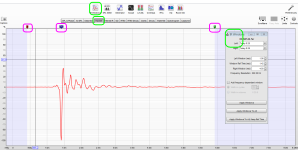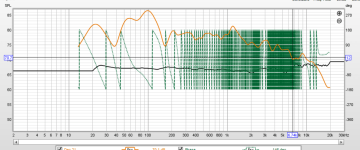Sorry if I had my wires crossed there 🙂This is JUST the woofer, in the cabinet no tweeter connected.
In any case, I have difficulty measuring down to low frequencies in a room, and it is inconvenient trying to work with a crossover and know the levels to use when there are modes showing (often especially below 200Hz).
One of the best things you can do is to gate your measurements. Get REW to ignore the measurement outside a start/finish time window that you set. This removes modes. It better focusses and smooths your higher frequencies and it limits your low frequency data.
Another thing some do is take nearfield measurements of their bass, but you don't have to do that just to make a crossover.
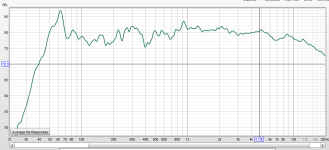
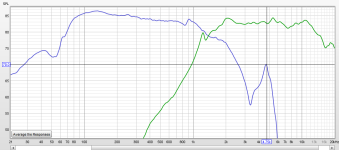
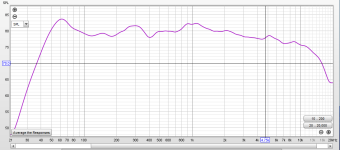
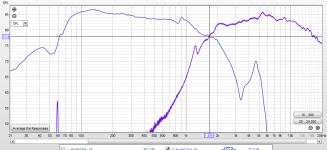
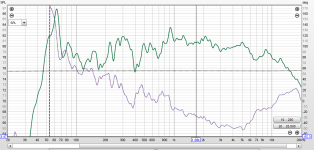
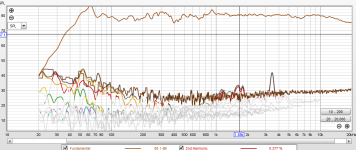
So here are some measurements - all are in room so there are some room mode issues. For instance, the peak on woofer at around 5k is likely room as I did not have that issue in the other room I measured in.
All full frequency (tweeter and woofer) are farfield at about 20 inches. All woofer and tweeter separates are nearfield.
All are shown with 1/24th smoothing.
Image 1 - woofer circuit is: 6.5 uH, with 14 uf cap and 2.4 ohm resistor. Tweeter is 12 uF and 8.8 ohm resistor, reverse polarity.
Image 2 is woofer and tweeter specs above showing 1.4 khz crossover.
image 3 - woofer - 6.5 uH, 14 uF and 2.4 ohm, tweeter 3.9 uF cap with 8.8 ohm resistor reverse polarity
image 4 - woofer and tweeter specs above showing 1.68 khz crossover.
the bump at 50 hz is the ports. I can add some stuffing and reduce that easily. The roll off above 16 khz is annoying but I cant hear high frequencies anyway so it doesn't really concern me.
So I am wondering what you might tweak and what my next steps would be. I have not listened yet to music so am solely going on the measurements. From the measurements - the first image is best but I am wondering if I should cross higher. I have tried a lot of combinations of component values. I only have a couple of inductor values so that is an area that i could explore though 6.5 on the woofer seems to be the best.
Allen - I could not figure out how to gate except for the settings in the impulse window - that is post measurement. Can you give me more details on how to eliminate room modes? Thanks.
The distortion is all below noise floor except for one peak in tweeter at 3.5 khz.
I have spent many hours getting here and learned a lot. I really appreciate your input and hope for helpful suggestions!
Thanks Allen. I now understand.
Do you have any feedback on the current measurements or would you want to see gated versions?
Do you have any feedback on the current measurements or would you want to see gated versions?
The combined and separates don't seem to match. Did you do them at separate times?
The response curves don't tell me much. Do you have a specific question on what you are trying to do today? ..like, what are you hoping to get out of changing the crossover frequency?
The response curves don't tell me much. Do you have a specific question on what you are trying to do today? ..like, what are you hoping to get out of changing the crossover frequency?
The separates were done nearfield and the combined farfield so I had to adjust the volume. to try to match the nearfield. - should I be measuring everything farfield for this part?
I changed out my woofer and am redoing the crossover completely. So I am doing a complete crossover from scratch with the ribbon tweeter and new woofer in a pre-existing cabinet. I am changing stuffing etc. I used your suggestions for initial values and have been adjusting based on the response curves.
I changed out my woofer and am redoing the crossover completely. So I am doing a complete crossover from scratch with the ribbon tweeter and new woofer in a pre-existing cabinet. I am changing stuffing etc. I used your suggestions for initial values and have been adjusting based on the response curves.
so my questions is - am I in the ballpark or do I need to adjust things - maybe move the crossover frequency higher?
The ribbon tweeter manufacturer uses 1800 hz in the spec sheet so I shot to get somewhere close to that.
The ribbon tweeter manufacturer uses 1800 hz in the spec sheet so I shot to get somewhere close to that.
Near measurements don't work for the higher frequencies and far measurements don't work for the lower ones.. but for different reasons. Try to do 1m or 2m measurements for your cross and accept the way the gating cuts out your low frequency information if you can, meaning if it's far enough below your cross.should I be measuring everything farfield for this part?
I can't tell that from the measurements. Consider the cone breakup and narrowing going to the tweeter.maybe move the crossover frequency higher?
Thanks guys - I do appreciate the help and suggestions. I do feel like I am making progress. I'll see what things look like measured a bit further away.
Yes, measurements aren't telling me much at this stage. I feel like I have the correct circuit for the woofer, so now I am listening and trying some different values for the tweeter. It sounds very good actually and it is interesting hearing the affects of the combination of cap and resistor value.
Allen, I do remember from your instructions not to favor the tweet too much even though it might sound good initially. Keeping that in mind.
the next step for me is to settle on a tweeter circuit then listen to both speakers.
Allen, I do remember from your instructions not to favor the tweet too much even though it might sound good initially. Keeping that in mind.
the next step for me is to settle on a tweeter circuit then listen to both speakers.
Once you get to know your tweeter, you can push it further in the interest of experimenting.
There are some things that you can't see from response measurements. You can find these out using common sense, but some use multiple (polar) measurements. The interest is in detecting such things as breakup, lobing and directivity..
These are important properties of a crossover.
You can instead navigate breakup and directivity by theory, such as limiting how high you take the woofer based on it's size. Lobing can be managed through phase.
There are some things that you can't see from response measurements. You can find these out using common sense, but some use multiple (polar) measurements. The interest is in detecting such things as breakup, lobing and directivity..
These are important properties of a crossover.
You can instead navigate breakup and directivity by theory, such as limiting how high you take the woofer based on it's size. Lobing can be managed through phase.
I have some slightly different values in the resistors as I don't have correct parts yet. the values are close. All the caps are matched.
ok, nevermind - I see in another article it is difficult to measure phase from distance in room due to reflections etc.
Phase is wrapping. It goes off the bottom of the chart and is drawn from the top again. This is caused by delay. It doesn't matter whether there are reflections as well, you deal with them by gating.
Remove the delay.
Remove the delay.
If you need to gate reflections out of a measurement, why don't you just measure outside ?
PS.
Going right back to the first thread-photo, your tweeter appears to have 'sliding alignment'. (?)
As Allen once said (in so many words) : 'Distance can amount to/manifest as Phase'.
PS.
Going right back to the first thread-photo, your tweeter appears to have 'sliding alignment'. (?)
As Allen once said (in so many words) : 'Distance can amount to/manifest as Phase'.
- Home
- Loudspeakers
- Multi-Way
- Help Tweaking Crossover
